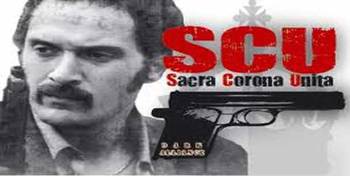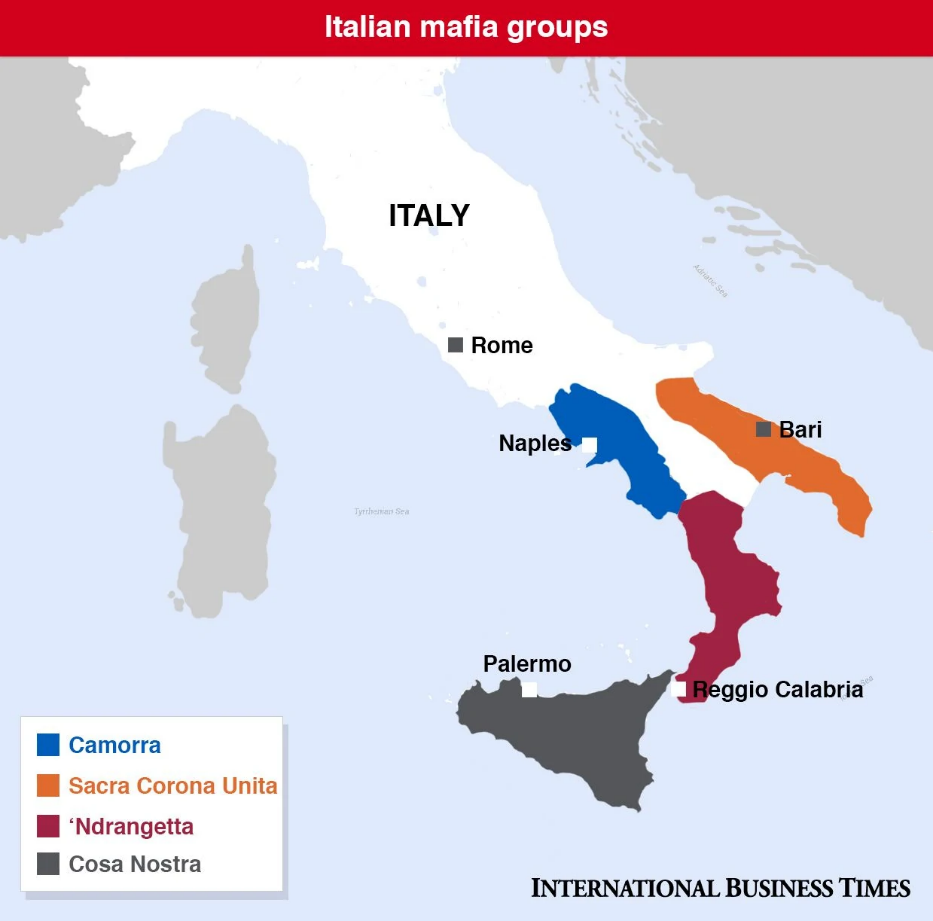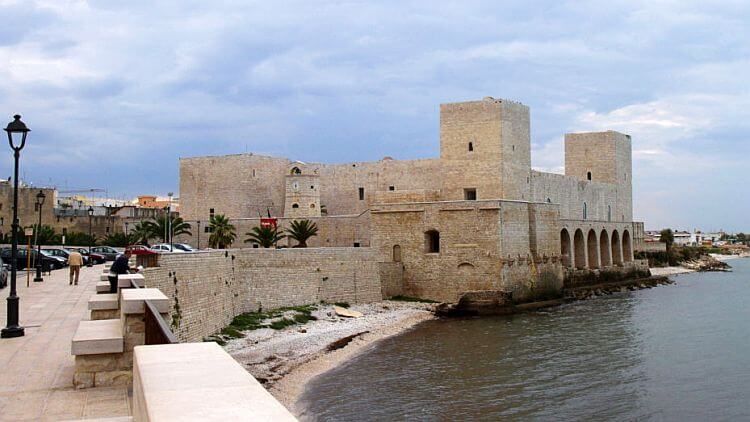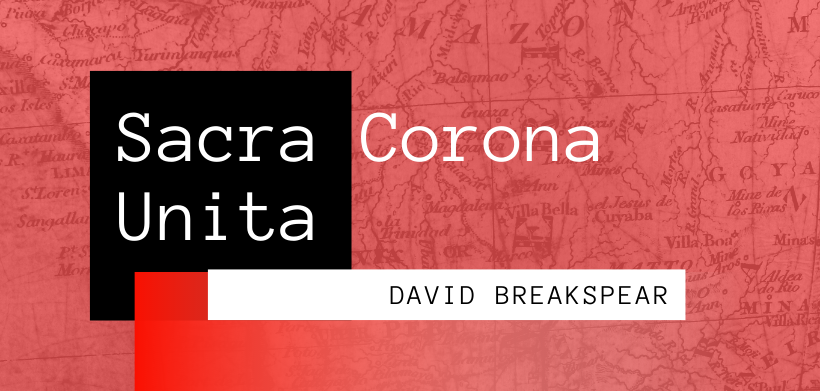‘I swear on the tip of this dagger, wet with blood, to be faithful to this body of formed society, to disown father, mother, brothers and sisters, up to the seventh generation’
In ‘The Fifth Element’, I outlined the history of the formation of the ‘Famiglia Basilischi’ who were officially recognised as the fifth mafia. A lot has been written about the main three: Camorra, ‘Ndrangheta and the Sicilian Mafia (Cosa Nostra), however, not much is known about the fourth. So, read on and find out more about this fourth Mafia who in the English translation is known as the ‘United Sacred Crown’.

In the 1990s, Italian authorities defined the Sacra Corona Unita (SCU) the ‘Fourth Mafia’. Not as well known as the Camorra, Cosa Nostra and ‘Ndrangheta the SCU are certainly growing in notoriety. And power. On Thursday 17th January 2020 and for the second time in two weeks members of the SCU attempted to blow up a witness in a move that led to Italian prime minister, Giuseppe Conte to go on Twitter and Tweet the following:
“The state, and citizens of Foggia, will not be cowed”
The target, Christian Vigilante is a key witness against local Mafiosi. So, who is the Sacra Corona Unita and where did they come from?

During a break in one of many trials, in which founding father of the Sacra Corona Unita, Giuseppe ‘Pino’ Rogoli was the main defendant, he began answering questions from the gathered media. He replied to one “The Sacra Corona Unita? It’s dead. In fact, it never existed.” And to another, he said “I am not saying we have not committed any crimes, but here among us, the Mafia culture of the Sicilians or the Calabrian’s does not exist, and we don’t have their resources either”1
Giuseppe Rogoli

Legend has it that Rogoli, in a ceremony that took place in his cell in 1983 while in prison (Trani on the Adriatic coast in Puglia) formed the Nuova Sacra Corona Unita in the presence of the man who had inducted Rogoli into the ‘Ndrangheta and who had now inaugurated this fourth Mafia, with Rogoli as its founding father, into the heart of the ‘Ndrangheta. Umberto Bellocco is the head of the Bellocco clan who is considered as one of the most powerful ‘ndrina in the ‘Ndrangheta. The Bellocco clan were also allied with the ‘ndrine of the Pesces’ who, together with the Piromalli-Molè ‘ndrina, controlled the port of Gioia Tauro in the province of Reggio Calabria, including the original construction contracts when the port was built.
The SCU began life towards the end of the 1970s as a bunch of disorganised criminal street gangs in the part of southern Italy that forms the ‘heel’ to the boot of Italy. Around the same time in the region of Campania Camorrista, Raffaele Cutolo founded the Nuova Camorra Organizzta (New Organised Camorra, NCO). In just a few years, not only did the NCO become a powerful clan within the Camorra, it became a big player within the Italian Mafia.
On Christmas Eve, 1980 in a move that would see war break out between the NCO and other clans, NCO members had tried to take territory controlled by the powerful Giuliano clan. Although not fatally, the head of the Giuliano clan Luigi Giuliano was shot and wounded. Not only did war break out but Cutolo’s NCO would be fought by a collaboration of clans known as the Nuova Famiglia (New Family, NF) led by Michele Zaza, the Nuvoletta brothers, and Antonio Bardellino. – During a trial in the 90s Zaza, when describing Cutolo’s NCO, told the judiciary “The whole world knows what they did, they felt, I don’t know like maybe they were strong, they felt they were like God Almighty” (Tribunale di Brindisi 1994, p. 183) – Peace was made between the warring factions at the end of January 1981, however, the following month on February 14 in a prison in Naples, three members of the NF were murdered by the NCO.
In 1983, with wars still being fought: the police, carabinieri and magistrates began a huge operation which lasted for 12 months. On one day, June 17, 1983, with a force of over 8,000 coordinated raids across Naples saw the arrest of over 850 Mafiosi. Newspapers in Naples dubbed the operation ‘Black Friday of the NCO’. High-ranked and powerful members of the NCO began to flip and became government witnesses. The NCO had lost its power. Raffaele Cutolo was finished.
The criminal gangs in the region of Apulia needed controlling, the ports of Puglia especially. To help him achieve this aim Cutolo had created the Nuova Grande Camorra Pugliese, which was the forerunner to the SCU.
Trani Prison

By the mid-1970s Italian authorities had relocated hundreds of NCO members from prisons in their home region of Campania to prisons in Puglia. In documents seized by authorities followed a raid on Rogoli’s prison cell they discovered the founding charter of the SCU in which Rogoli had written the date of formation as May 1983, in one of Puglia’s prisons the prison in Trani, “to regulate and settle various issues arising between prisoners” the Sacra Corona Unita was born. In fact, the main reason was as an attempt to control the power inside the prisons as well as containing the power in regions across Apulia.
“Law enforcement became aware of the Sacra Corona Unita—translated to “United Sacred Crown”—in the late 1980s. Like other groups, it started as a prison gang. As its members were released, they settled in the Puglia region of Italy and continued to grow and form links with other Mafia groups. The Sacra Corona Unita specializes in smuggling cigarettes, drugs, arms, and people. It is also involved in money laundering, extortion, and political corruption. The organization collects payoffs from other criminal groups for landing rights on the southeast coast of Italy, a natural gateway for smuggling to and from post-Communist countries like Croatia, Albania, and the former Yugoslavia.”3
The lucrative olive oil industry of Apulia, influenced by EU subsidies of up to €1,000 per hectare has seen landowners bankrupt along with kidnapping, arson and murder. The Mafia made them offers, they couldn’t refuse, but they did.
In the Court of Bari on the 22nd January 2019. 18 years after the first hearing, which had taken place on the 5th July 2001, Giuseppe ‘Pino’ Rogoli already in prison since 1992 received another life sentence that Rogoli must continue to serve under the much-maligned Article 41-bis of the Italian Prison Administration Act, also known as the ‘hard prison regime’ (carcere duro). Rogoli has been in prison under 41-bis since 1992.
To give you some idea as to the extent to which this restricted the prisoner. I took the list below from an appeal to the European Court of Human Rights in Strasbourg by alleged Mafia member Salvatore Enea in September 2009.
‘On 10 August 1994, in view of the danger posed by the applicant, the Minister of Justice issued a decree ordering that he be subject for one year to the special prison regime provided for in the second paragraph of section 41 bis of the Prison Administration Act (“Law no. 354 of 1975”). This provision, which was amended by Law no. 279 of 23 December 2002 (“Law no. 279 of 2002”), allows application of the ordinary prison regime to be suspended in whole or in part for reasons of public order and safety.’
The 1994 decree imposed the following restrictions:
– restrictions on visits by family members (a maximum of a single one-hour visit per month);
– no meetings with non-family members;
– prohibition on using the telephone;
– no sums of money above a fixed amount to be received or sent out;
– no more than two parcels to be received per month, but permission to receive two parcels per year containing clothing and linen;
– ban on organising cultural, recreational or sports activities;
– no right to vote in elections for prisoners’ representatives or to be elected as a representative;
– no craft activities;
– no food requiring cooking to be purchased;
– no more than two hours’ outdoor exercise per day.
In addition, all the applicant’s correspondence was to be monitored, subject to prior authorisation by the judicial authority.
The application of the special regime was subsequently extended on nineteen occasions for successive periods of one year or six months.
Each decree covered a limited period, as follows:
- 10 August 1994 – 9 August 1995 (decree no. 1)
- 5 August 1995 – 5 February 1996 (decree no. 2)
- 2 February 1996 – 2 August 1996 (decree no. 3)
- 31 July 1996 – 31 January 1997 (decree no. 4)
- 4 February 1997 – 4 August 1997 (decree no. 5)
- 31 July 1997 – 31 January 1998 (decree no. 6)
- 4 February 1998 – 4 August 1998 (decree no. 7)
- 30 July 1998 – 30 January 1999 (decree no. 8)
- 27 January 1999 – 27 July 1999 (decree no. 9)
- 22 July 1999 – 31 December 1999 (decree no. 10)
- 23 December 1999 – 23 June 2000 (decree no. 11)
- 22 June 2000 – 31 December 2000 (decree no. 12)
- 21 December 2000 – 21 June 2001 (decree no. 13)
- 18 June 2001 – 18 December 2001 (decree no. 14)
- 13 December 2001 – 13 June 2002 (decree no. 15)
- 10 June 2002 – 31 December 2002 (decree no. 16)
- 28 December 2002 – 22 December 2003 (decree no. 17)
- 23 December 2003 – 23 December 2004 (decree no. 18)
- 17 December 2004 – 17 December 2005 (decree no. 19)’.4
In December 2010, the carabinieri arrested two dozen high ranking members of the SCU. On Saturday, April 23, 2011, the alleged boss Francesco Campana was arrested as can be seen in the YouTube video link.
“The capture of Campana – commented Minister Maroni – is a severe blow to the sacred crown united, the result of efforts that have been made in Puglia through the work of special investigative groups, set up precisely to capture the fugitives and to end the bloody mafia war in that territory “.5
Campana had been sentenced in his absence to 9 years for Mafia-related crime in May 2010 but had been in hiding since 2009. On the 27th September 2010 in a raid at a villa in Porto Cesareo, Campana’s brother Sandro was arrested. Sandro Campana subsequently collaborated with the authorities providing a statement of over 200 pages.

“My very painful decision to collaborate with justice stems first from the fact that before leaving the Teramo prison in September 2014 my brother Francesco had sent me a sheet through other people where he reminded me that, being like him a person at the top of the historic Scu and in addition both undisputed heirs of our old founder and our historical godfather Giuseppe Rogoli, it was up to me to carry on by taking on all the responsibilities of all our affiliates and all the illegal activities carried out by us, also because he, having a very delicate process, did not want to precipitate his position risking the 41 bis. In this context, he asked me that the time had also come for me to immediately break the pax mafia made by myself with my brotherly friend Pasimeni Massimo in February-March 2008, in the Lecce prison, where we had seen each other after so many years. “On that occasion, Pasimeni and I had sworn and promised each other that no more Mafia wars would ever arise between Mesagnesiin order to avoid even murders for anything”6.
On his status, Campana specifies his position, ties and evolutions. “I was elevated to the rank of medallion with the right of chain at the end of 2007 on the order of Giuseppe Rogoli, my historical godfather who had commissioned and authorized him to confer this rank on me. Later in the prison of Teramo, Umberto Bellocco, known as the lame, only gave me the degree of ‘criminal law’ orally. It is a higher grade than the one I covered, characteristic of the Calabrian associations. The relative oath was not made because he was released from prison.”7
The following is the translated text taken from a letter that Francesco Campana sent to a journalist at the Gazzetta del Mezzogiorno after he had heard the news of his brother, Sandro’s betrayal.
“Iacta alea est”. Although the undersigned would prefer silence, I feel the moral need to dissociate myself from Sandro Campana’s recent decision to collaborate with the investigators. I specify that I distance myself from the unacceptable position of the aforementioned neo-collaborator of justice.
Based on the existential context of my twenty-three years of detention and the accusations made by seventeen collaborators of justice (Semeraro Alceste, Di Coste Francesco, Bellanova Giuseppe, D’Amico Massimo, Belfiore Emanuele, Greco Antonio, Leo Giuseppe, Leo Cosimo, Panico Fabio, Greco Leonardo, Passaseo Giuseppe, Caforio Simone, Perez Alessandro, Guarini Cosimo Giovanni, Gonoli Achille, Penna Ercole, Gravina Francesco alias Gabibbo) discordant and contradictory to each other, which have not led the investigators to identify an authentic principle of truth, not I am very surprised at this point if one more collaborator of justice has been added. However, on the moral level it afflicts me that it was a blood relative.
Since the collaboration of a citizen deprived of personal liberty is probably based on the logic of “do ut des”, I would like to know what degree of convenience has been granted and / or promised to him. This taking into account that the editor of the article of 25 August 2015 published in the “Gazzetta del Mezzogiorno” of Brindisi reveals the mere role of the new collaborator within the alleged association … In fact, no collaborator (not even Penna) has ever spoken of him … if not as a brother of the undersigned [sic].
I take this opportunity to point out to the journalist (very coherent in his work – that’s why I chose the page of the Gazzetta del Mezzogiorno di Brinisi – Mr. Piero Argentiero) that the undersigned is absolutely not “enrolled” at the university of the Apulian mafia (very joke unhappy and inappropriate) but at the State University of Pavia, Faculty of Imanistic Studies-Philosophy, with the firm hope of achieving a degree as soon as possible.
With treats
Francesco Campana
Voghera, 2 September 20158
Structure

The rituals of the SCU, like those of the ’Ndrangheta, make frequent reference to the three Spanish knights Osso, Mastrosso, and Carcagnosso who, according to legend, was part of the secret Spanish society called Garduña, formed in Toledo in 1412. SCU consists of around 1,500 members spread over approx. fifty individual clans. The hierarchy is made up of three levels. Società Minore (minor), Società Maggiore (major) and Società Segreta (secret). Upon induction into the SCU a new member would begin at the Minore level as a picciotti reciting ‘I swear on the tip of this dagger, wet with blood, to be faithful to this body of formed society, to disown father, mother, brothers and sisters, up to the seventh generation […]”. A person would spend up to forty days on probation, this is done so that they can prove their worth as a criminal while also showing they have no links with the authorities. Once a picciotti has passed the probation period they are inducted into the clan as a manovalanza.
The Maggiore level is achieved once a candidate has shown themselves worthy. Like the Minore level, this level consists of two statuses, Lo Sgarro and La Santa. To be known as Lo Sgarro a member, under orders of the SCU, would have to have committed a minimum of three murders. Those at the Lo Sgarro level, recognisable by a tattoo of a rose on their right foot, are permitted to now create their own clan. The riti battesimali (rites of baptism) to the status of La Santa within the Maggiore level is held specifically at midnight. Those being inducted are also provided with a list of symbolic items.
“Another peculiar element in the rituals adopted by the SCU is represented by the use, during the ceremony, of special symbolic objects that represent, for all practical purposes, real ritual tools. In addition to the pin, used to make the incision on the hand or finger and called armatura (armor) in the language of the ’Ndrangheta, and the small sacred image, depicting Saint Michael the Archangel in both the SCU and the ’Ndrangheta, these also include: the white silk handkerchief, which represents the purity of the soul of the initiate; the spartenza (shared goods), frequently symbolized by several cigarettes, which—as the legacy of the association—must be equally shared among the participants in the ritual; a poison pill as a means for committing suicide in case the principles of loyalty to the organization are ignored; a gun to punish the member in case of betrayal; a lemon, which serves to “heal the wounds of our wise comrades”; and a ball of cotton, which, according to legend, symbolizes Mont Blanc, a place considered holy”
The top, and final level, Segreta, is where the power base of the SCU sits and the decisions are made by the General Council, like the commission formed by Charles ‘Lucky’ Luciano et al in America many years before. The final riti battesimali contains the oath: “I swear to no longer accept any other dote from any other body of association, aside from this one, composed of the established Holy Circle of Honor.”
The following video, to a YouTube video (in Italian only), is a perspective of the SCU.
References:
1(PDF) The Sacra Corona Unita: Origins, Characteristics, and Strategies. Available from: https://www.researchgate.net/publication/299847173_The_Sacra_Corona_Unita_Origins_Characteristics_and_Strategies [accessed Jan 19, 2020].
2Tribunale di Brindisi. (1994, Sept 27). The sentencing of Giovanni Buccarella and ten others.
3 https://www.fbi.gov/investigate/organized-crime#Italian-Organized%20Crime/Mafia [accessed Jan 18, 2020]
4https://r.search.yahoo.com/_ylt=AwrP4o2LRCVeTQ8AeSMM34lQ;_ylu=X3oDMTByaW11dnNvBGNvbG8DaXIyBHBvcwMxBHZ0aWQDBHNlYwNzcg–/RV=2/RE=1579529484/RO=10/RU=https%3a%2f%2fswarb.co.uk%2fenea-v-italy-echr-17-sep-2009%2f/RK=2/RS=nhFu7bIbF92ZpD35dfoO8KpRtQ4- [accessed 20 Jan, 20)
5http://www.ilgiornale.it/news/puglia-sacra-corona-unita-manette-campana-super-boss.html [accessed Jan 19, 2020].
6/7/8http://www.lostrillonenews.it/2015/09/17/scu-fratello-contro-fratello-sandro-campana-racconto-tutto-francesco-che-ti-hanno-promesso/ [accessed Jan 19, 2020]
9(PDF) The Sacra Corona Unita: Origins, Characteristics, and Strategies. Available from: https://www.researchgate.net/publication/299847173_The_Sacra_Corona_Unita_Origins_Characteristics_and_Strategies [accessed Jan 20, 2020].
Other sources:
http://silpbrindisi.blogspot.com/2011_04_01_archive.html
- Ciro Dapagio’s MobKing: Trailer & Review - July 24, 2023
- LUCKY: A True Crime Graphic Novel - April 25, 2023
- The Theft of The Marlborough Diamond – Chapter 2 - February 14, 2023









